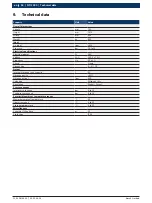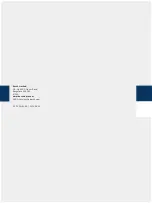
F 002 DG9 A00
2013-04-16
|
Bosch Limited
8 | N�� ���� | Product description
en
4.
Commissioning
4.�
Removing the transport packaging
!
Dispose of the packaging material in accordance
with governmental guidelines. Do not dispose of the
packaging material along with household waste.
4.�.�
Opening the N�� ����
The NTI 1000 along with necessary accessories are
packed in a wooden crate.
1.
Visually, check if there is any damage to the packing
case.
i
If the packing case shows even the slightest signs of
damage or if there is distortion in shape, report to
the transporter immediately. Immediately, report the
extent of damage to Bosch Limited.
2.
Move the packing case containing the NTI 1000 to
the installation site.
3.
Dismantle the packaging case on any of the sides.
4.
Cut open the plastic cover.
5.
Remove the foam protection on the HMI, FRC, hose
holder and hose connection ports.
6.
Check if all the items/accessories listed in the deliv-
ery specification are available with the NTI 1000.
i
If any of the items in the scope of delivery are not
delivered, report to Bosch Limited.
4.�.2
Opening the nitrogen tank
1.
Visually, check if there is any damage to the packing
case.
i
If the packing case shows even the slightest signs of
damage or if there is distortion in shape, report to
the transporter immediately. Immediately, report the
extent of damage to Bosch Limited.
2.
Move the packing case containing the installation
site.
3.
Dismantle the packaging case on any of the
sides.
4.
Cut open the plastic cover.
�.5.�
CMS and nitrogen tanks
Two CMS tanks are used to convert air to nitrogen. The
separated nitrogen is collected in a storage tank for fur-
ther distribution. The CMS tanks and nitrogen storage
tank are firmly fixed and bolted to the cabinet.
�.5.2
Filters for water and oil separation
The input pneumatic line is connected to the Filter Reg-
ulator Combination (FRC) which acts as an input device
and filtration device. Air from the compressor at 10 bar
is passed through the FRC where the moisture, dirt and
oil are filtered. The collected moisture, dirt or oil can be
discharged manually by opening the drain on the FRC.
�.5.�
Hose for inflation
Air or nitrogen is filled into the vehicle tire via a 12 m
filling hose. A filling nozzle fixed to the hose is used
to connect the filling hose to the vehicle tire. When
not in use, the filing hose is wound to the hose holder
(Fig. 2, Pos. 3).
�.5.4
Human Machine �nterface (HM�)
A HMI unit on the front panel provides the control
needed for selection of nitrogen or air for tire inflation.
The pressure can be set through the input keys on the
keypad (Fig. 1, Pos. 4). The pressure sensor detects the
tire pressure. Based on the set pressure and mode, the
tire is filled with nitrogen or air via solenoid valves. The
result of the operation is displayed on the LCD screen.
A pressure gauge is used for indicating the pressure in
the nitrogen storage tank. LEDs are provided to indicate
the status of service.
LED status
�ndication
Red LED glows
Completion of inflation or de-
flation
Blue LED glows
Air mode selected
Green LED glows
Nitrogen mode selected
�.5.5
Power cable and master switch
The NTI 1000 is connected to 230 VAC
10%, 50 Hz
1%
.
supply via a power chord. The NTI 1000 can be
powered on by turning the master switch in the clock-
wise position.
�.5.6
Vacuum pump (optional)
The vacuum pump (Fig. 3, Pos. 3) is used for deflation.
The vacuum pump can be switched on or off by select-
ing the
Deflate
option from the main menu. Refer chap-
ter 6 for more details about the software functions.
Содержание NTI 1000
Страница 1: ...NTI 1000 en Original instructions Nitrogen tire inflator ...
Страница 2: ......
Страница 19: ......






































